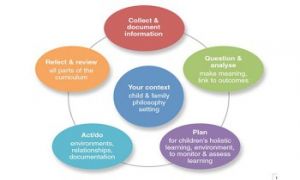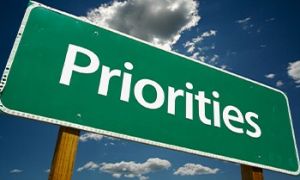The physical environment in an early childhood setting creates an atmosphere that is welcoming, inviting and engaging. For the children it is an atmosphere where they can develop their skills and interests and become independent and confident learners. The overall learning environment creates a feeling of safety and comfort- a place where all children belong.
An environment that is well established and properly designed supports a child growth and development. It provides an opportunity for educators to observe and interact with children in a positive ways and encourages children to achieve learning goals.
Furniture and Materials
When setting up the physical environment, the layout and organization of furniture and the materials used needs to be taken into consideration. Whether the room environment is small or large, the arrangement of the room plays an important part of a child’s overall learning and development.
- Having a large open space - of area for children to play in can cause more harm than good. It invites children to run rather than to walk that’s why it’s important to break up large space within in a room into smaller defined areas.
- Tables, chairs, shelves and mats - can all be used to define key areas and enable children to understand boundaries during play. It also encourages appropriate behaviour. Not all activities need tables and chairs so it’s a good idea to figure out what activities will be placed on tables and mats.
- Shelves - can be used to define areas. Instead of placing a shelf up against a wall it can be placed at right angles to provide a specific space for that experience. It will enable children to understand where the experience starts and ends within the area. Using mats also helps to identify key areas. If mats are not available, use masking tape along to floor as a limit. When areas and spaces are defined children are able to focus and concentrate more on the experience they are engaged in, rather than be distracted by other activities.
- Materials - should be displayed in an inviting way. There is no need to overcrowd shelves with lots of different objects. Limit these to just a few which will encourage children to make choices on the materials they choose. Try and use natural materials such as wooden or cane baskets to hold items. Use large rocks or logs to create barriers. For sorting, matching or counting activities items such as seed pods, leaves, sticks, pebbles or shells can be used. Add indoor plants and provide real objects for children to use. Instead of using plastic kitchen equipment in home corner, use unused pots, pans, wooden spoons, glasses, plates etc. The use of natural materials enables children to explore elements of the environment and supports them to become environmentally responsible.
Wall Displays
Another important feature of the physical environment is how to decorate the walls. It’s a good idea to set aside a “wall” for an individual purpose. What is displayed on a wall creates a sense of belonging to children and their families. Posters, arts and crafts, photos can all be added to provide a welcoming and attractive environment.
- Programming and planning essentials – can be displayed on a wall near the entrance (near the sign in/sign out area) This can include the curriculum plan, daily diary, child daily information chart, weekly menu, calendar of events etc. This area should be constant and be accessible to parents to view the day’s happenings.
- Art Work – instead of hanging art work all around the room you can use one wall and create a gallery of children’s art. When displaying art use name cards and place them under each individual’s child’s art work. This enables parents to identify their child’s art work clearly. Also create a banner/ title of the art on display so it can be easily identified, for example “Marble Painting”. Another option in displaying art is to only use one child’s work to be displayed in the gallery, per experience. This eliminates the need to have the same art work displayed over and over again, especially if you are only using one wall. For example, when children are doing string painting, it may not be necessary to display 20 of the same string paintings which use the same technique and the same outcome, choose one and display it in the gallery while the others are added into portfolios etc. However if the experience is drawing, since each child’s ideas are different, these all can be displayed.
- Photo Wall – children love looking at photos and having a photo wall can provide them with a sense of belonging within the Centre. The photos should be displayed at children, level and can be set in a theme so they can be changed over time. Themes can include: Emotions, Developing Friendships, Sharing, Through Our Eyes etc. When adding photos to a photo wall it’s always a good idea to add a brief description that lets others know about the purpose of the photos and why they are being displayed.
- Birthday Calendar – this can be displayed where it is visible to all. Next to the b’day calendar add a sign or poster that says “Happy Birthday to ...” or “Today is ... birthday” and add the child’s photo on their birthday while attending the centre.
- Posters – can be displayed to convey meaning, support understanding or develop awareness. Animals, people, the environment, world around us can all be displayed. When displaying posters it’s best to stick to one particular topic rather than have random posters displayed throughout the room. It can look messy, unappealing and lose its meaning. Choose posters based on children’s current interests or to extend on learning, for e.g. if you happen to be celebrating a cultural celebration then having posters related to the celebration will enable children to gather a better perspective. As they say “a picture tells a thousand words”.
It may seem like a lot of walls are needed to create each of the displays mentioned above, they are not compulsory and are only to be used as a guide as an idea on how to organize the wall space within the environment. As long as the displays promote inclusiveness, support diversity and express meaning that is the most important.
Interest Areas
One of the beneficial ways to design a positive learning environment is through interest areas. These are commonly used to support a play based learning curriculum and provides a predetermined area in which to set up experiences based upon each individual interest area. The physical environment can be organized into the following:
- Art and Craft
- Block Play
- Computer Area
- Construction Area
- Cooking Area
- Home Corner
- Library Area
- Music and Movement
- Outdoor Area
- Puzzle Play
- Sand and Water Area
- Science and Nature
- Sensory Play
- Toy Table
Interest areas will offer an environment for the children to explore and discover, an opportunity for the children to grow.
NQS – Quality Area 3: Physical Environment
This quality area of the National Quality Standard focuses on the physical environment and ensuring that it is safe, suitable and provides a rich and diverse range of experiences which promote children’s learning and development.
According to the National Quality Standards, the indoor environment is characterised by open spaces that provide children with opportunities to work on self-chosen and negotiated activities, both quiet and active learning situations, routines and small-group and whole-group experiences.
These spaces:
- support children’s emerging interests and allow them to demonstrate their innate creativity and curiosity
- reflect children’s different cultures, interests, abilities and learning styles
- recognise children as active learners and decision makers
Within Quality Area 3: Physical Environments, each element listed provides details on requirements needed for an early childhood setting to comply with. In the table below, the elements listed are those which directly impact the indoor environment. Examples of Every day Practices will also be provided in order to maintain the standard needed to fulfil each element. This is to be used as a guide only and more detailed information can be found within the National Quality Framework itself.
Element 3.1.1 -
- Outdoor and indoor spaces, buildings, furniture, equipment, facilities and resources are suitable for their purpose.
Examples of Every Day Practices
- Children engaging in a variety of experiences and activities in both the indoor and outdoor environments
- Children having access to furniture, materials and equipment adequate in number and suitable for the educational program
- Enough toys, equipment and resources to minimise disputes between children over their use
Element 3.1.2 -
- Premises, furniture and equipment are safe, clean and well maintained furniture and equipment that are safe, clean and well maintained
Examples of Every Day Practices
- Educators following safety advice from recognised authorities and manufacturers when arranging equipment, furniture and experiences
Element 3.1.4 -
- Facilities are designed or adapted to ensure access and participation by every child in the service and to allow flexible use, and interaction between indoor and outdoor space
Examples of Every Day Practices
- Facilities that are welcoming to children and families from a range of cultural backgrounds
- Educators engaging children in constructing their own play settings and creating indoor environments which stimulate and reflect children's interests
- educators involving children in making and maintaining aesthetically pleasing environments
Element 3.2.1 -
Outdoor and indoor spaces are designed and organised to engage every child in quality experiences in both built and natural environments.
Examples of Every Day Practices
- Safe shelving and storage areas from which children can access equipment and resources that are age and capability appropriate
- Children initiating their own experiences using equipment and resources they can access independently
- Environment is flexible in the arrangements of furniture and equipment and includes open-ended materials to encourage children to become flexible thinkers, problem solvers and investigators
Element 3.2.2 -
Resources, materials and equipment are sufficient in number and organised in ways that ensure appropriate and effective implementation of the program.
Examples of Every Day Practices
- Children using a range of real, commercial, natural, recycled and simple homemade materials to support their learning
- Enhancing child initiated experiences by providing additional resources and, where appropriate, participating in and extending their play
- Resources, materials and equipment that are inclusive and reflect the lives of the children in the service, their families and the cultural diversity of the broader community
Designing, organising and maintaining the physical environment encourages children to interact and explore with their surroundings, to make meaning and knowledge through their experiences, social interactions and negotiations with others. An environment that is safe, attractive and comfortable will allow the children to engage in the experiences that are offered.
References
EYLF & NQS


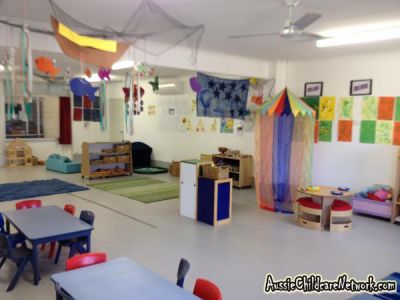
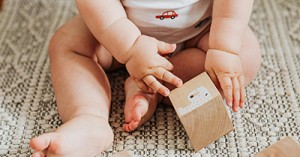
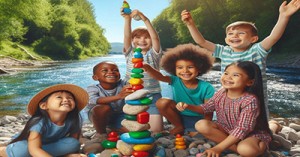


 As an Educator in Australia, your pay rate falls under the Children’s Services Award 2010. This award states the minimum amount that an employer can
As an Educator in Australia, your pay rate falls under the Children’s Services Award 2010. This award states the minimum amount that an employer can When working as a qualified Early Childhood Teacher (with a university degree) within a service, your rate of pay will come from the Educational Services
When working as a qualified Early Childhood Teacher (with a university degree) within a service, your rate of pay will come from the Educational Services When working as a Diploma Qualified Educator your pay rate is from the Children's Services Award 2010. This Award states your minimum rate of pay
When working as a Diploma Qualified Educator your pay rate is from the Children's Services Award 2010. This Award states your minimum rate of pay When working as a Cert 3 Qualified Educator, your pay rate is from the Children's Services Award 2010. This Award states your minimum rate of
When working as a Cert 3 Qualified Educator, your pay rate is from the Children's Services Award 2010. This Award states your minimum rate of Educational Leaders play a crucial role in their early childhood service by ensuring that the educational program aligns with best practices and supports the holistic
Educational Leaders play a crucial role in their early childhood service by ensuring that the educational program aligns with best practices and supports the holistic In early childhood education and care, ratios are more than a technicality—they are a frontline safeguard. Every child deserves responsive supervision, emotional connection, and developmental
In early childhood education and care, ratios are more than a technicality—they are a frontline safeguard. Every child deserves responsive supervision, emotional connection, and developmental With the new national child safety reforms kicking in on 1 September 2025, early childhood services like yours have a real opportunity to lead the
With the new national child safety reforms kicking in on 1 September 2025, early childhood services like yours have a real opportunity to lead the Here’s a comprehensive Mobile Phone and Smart Watch Policy tailored for early childhood education and care (ECEC) services in Australia, aligned with the latest 2025
Here’s a comprehensive Mobile Phone and Smart Watch Policy tailored for early childhood education and care (ECEC) services in Australia, aligned with the latest 2025 The Sea of Fish Challenge is a national initiative that invites children, educators, families, and communities to create and display fish artworks as a symbol
The Sea of Fish Challenge is a national initiative that invites children, educators, families, and communities to create and display fish artworks as a symbol Across the early childhood education and care sector, educators are sounding the alarm: current staffing ratios are insufficient to deliver safe, meaningful, and developmentally appropriate
Across the early childhood education and care sector, educators are sounding the alarm: current staffing ratios are insufficient to deliver safe, meaningful, and developmentally appropriate
